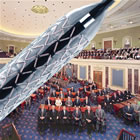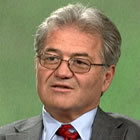 Monday’s 172-page Senate Finance Committee Staff Report on the overuse of coronary stents by Dr. Mark Midei at St. Joseph’s Hospital in Maryland has been all over the news — over 300 articles to date, claiming fraud, malpractice, pig roasts, threats to reporters — all of which serve to rekindle the “anti-stent” sentiment that followed on the heels of the COURAGE study back in 2007. In fact, Dr. William Boden, principal investigator for COURAGE, was interviewed for the Senate report, which characterized him as follows:
Monday’s 172-page Senate Finance Committee Staff Report on the overuse of coronary stents by Dr. Mark Midei at St. Joseph’s Hospital in Maryland has been all over the news — over 300 articles to date, claiming fraud, malpractice, pig roasts, threats to reporters — all of which serve to rekindle the “anti-stent” sentiment that followed on the heels of the COURAGE study back in 2007. In fact, Dr. William Boden, principal investigator for COURAGE, was interviewed for the Senate report, which characterized him as follows:
Dr. Boden was the lead investigator of COURAGE, a 2007 Department of Veterans Affairs funded study published in the New England Journal of Medicine. According to the Wall Street Journal, COURAGE “shook the world of cardiology” when it found that cardiac stent procedures, also referred to as percutaneous coronary interventions (PCIs) “usually yield no additional benefit when used with a cocktail of generic drugs in patients suffering from chronic chest pain.”
Well that sort of indicts the entire world of interventional cardiology, doesn’t it? (Not to mention that Senators seem to go for anything with the word “cocktail” in it.) This Senate report is saying that stents are basically useless! Just take your generic drugs and you’ll be fine. Of course, unmentioned is that fact that the COURAGE study received considerable funding from Big Pharma. Also unmentioned is the fact that 1/3 of the COURAGE medicine-only cohort wound up switching over to stenting because their pain was not being relieved. For our analysis of COURAGE, read our article: “Don’t Cancel Your Angioplasty or Heart Stent Yet, Say Patient Advocates.”
Back to my point: the Senate report quotes (above) a somewhat flawed Wall Street Journal article that appeared earlier this year, titled “A Simple Health-Care Fix Fizzles Out” — you can read my way too lengthy critique of that article here: “Stents Downgraded by Wall Street Journal: If Only It Were That Simple .”
COURAGE is actually a very important study and the real message is that it is okay to take a “wait and see” strategy when dealing with stable angina patients; that you are not endangering their lives by treating them with “optimal medical therapy” first. If they don’t improve, you can always implant a stent at a later date. This was already the recommendation in the practice guidelines for stable angina — and COURAGE gave this approach more weight.
But the message was NOT that stents are unnecessary — in fact, in the case of acute myocardial infarction (AMI), stents are considered to be the gold standard of care! Implanting a stent in a patient who is having a heart attack can actually stop the heart attack from progressing, saving heart muscle and preventing a life limited by heart failure. I discuss this in my blog post, “Heart Attack and Angioplasty: A Public Education Challenge” and I mention Dr. William O’Neill, who pioneered the use of angioplasty in cases of heart attack.
 Well I spoke with Dr. O’Neill about the situation in Maryland earlier this week. Because he has a unique perspective on the stenting done by Dr. Midei — he was asked by Midei’s legal team to review many of the cases in question. He also has strong feelings about the way this case has been characterized in the press. Here’s what Dr. O’Neill told Angioplasty.Org about Dr. Midei:
Well I spoke with Dr. O’Neill about the situation in Maryland earlier this week. Because he has a unique perspective on the stenting done by Dr. Midei — he was asked by Midei’s legal team to review many of the cases in question. He also has strong feelings about the way this case has been characterized in the press. Here’s what Dr. O’Neill told Angioplasty.Org about Dr. Midei:
I’ve looked at his records and I’ve actually interviewed him on a case by case basis to understand what he was thinking…. And there’s always things you could do differently. But I looked at over 100 films. And an operator’s patterns will emerge. He could be operating on completely clean coronaries, which he never did. He could be doing totally ridiculous kinds of procedures, which he never did. And he could have been deploying stents in incorrect ways, which he wasn’t. So my conclusion was that he was a very fast, very efficient operator and I saw nothing that was incorrect in the way that he was performing cases.
What I’m really concerned about is that this is the kind of media circus that destroys the lives and reputations of innocent people. And we have this culture now of “guilty until proven innocent.” Both of the articles in the New York Times and in the Wall Street Journal just started all of this with the assumption that Midei has been guilty of something…. And the initial premise is incorrect.
So when do we correct the record for this guy when all is said and done? He’s going to be exonerated at his trial. He hasn’t been convicted of any crime and there haven’t been any medical sanctions brought against him, so for God’s sake, give the guy the presumption of innocence until something is actually proven that he did wrong.
O’Neill went on to discuss where the real controversy is: cases where the blockages were in the area of “intermediate severity.” On an angiogram, these blockages might look moderate or mild, but O’Neill said Midei had a clinical rationale for performing stenting on these patients.
As I’ve written over the past few days, much of this controversy of whether or not these blockages were significant enough to stent, might have been resolved through the use of a new tool, called Fractional Flow Reserve (FFR). But FFR was not available at Midei’s hospital (although he claims he had “pushed for it”); instead he had to rely on the patient’s clinical symptoms and the X-ray video, called an angiogram.
Dr. O’Neill also had comments on the accuracy of angiograms:
I think we’ve known for almost 25 years that visual assessment of angiograms is irreproducible and inaccurate. Every angiographer knows you can go frame by frame and make a lesion anywhere from 20-70% just by the frame that you pick when you look at an angiogram. The lesson that the interventional community needs to learn is that you have to be really careful about documenting why you are treating moderate severity lesions. And when in doubt, either use IVUS or an FFR to make sure that you can prove to people that the lesion is severe enough to need to be treated.
A final part of this story(and please forgive the length of this post — but on Monday I did warn you…) — the final part is the “involvement” of the stent manufacturer Abbott. There are a number of emails back and forth between Abbott executives and Dr. Midei. One from John Capek, who headed up Abbott’s vascular division, congratulated Midei for having implanted a record 30 stents in one day. Another from Dave Pacitti, Abbott VP of Global Marketing was a bit rougher — when Baltimore Sun business reporter Jay Hancock penned some of the initial accusations against Midei, Pacitti emailed a subordinate in Baltimore, “Someone needs to take this writer outside and kick his ass! Do I need to send in the Philly mob?” Ouch.
And then there was the $2,000 smoked pig roast that Abbott provided for Midei and his cath lab staff (prices vary, depending on which newspaper you read). And finally, when Midei lost his privileges at St. Joe’s, Abbott hired him on as a $30,000-plus consultant to teach others (here and abroad) about their new drug-eluting stent, the XIENCE V.
The accusations against Abbott are that they were pushing the use and overuse of their stent — that making money was all that mattered. And reading through the emails quoted in the Senate Report reveals an undeniable and appalling insensitivity, especially to anyone “outside” of the industry.
Of course, no one at Abbott was thinking “outside” the industry; they were consumed by something else.
Abbott’s second generation XIENCE V drug-eluting stent (DES) was approved by the FDA on July 2, 2008. This was the first drug-eluting stent approved in the U.S. in over four years. It was also the first major product for Abbott Vascular, which was formed two years earlier when Boston Scientific bought Guidant and spun off the stent division to Abbott Labs. (Abbott Vascular even moved into Guidant’s old HQ in Santa Clara, California.)
Suddenly Abbott was in a position to take on Boston Scientific’s market-leading TAXUS stent. Without question, during the summer of ’08, the competitive juices were flowing in Santa Clara. The company finally had a shot at a multi-billion dollar market (XIENCE has since prevailed, becoming the dominant DES — for now). Midei’s “30 stent day” occurred less than 2 months after FDA approval. So the enthusiasm which I can only characterize as “football fever”, having seen sales forces erupt in cheers during the presentation of a positive clinical study — this was the subtext for all the celebrating around Midei’s work. (For the record, all of the studies of the XIENCE V stent have shown it to be superior to the earlier generation of DES: safer and more effective…just sayin’.)
But accusations of fraud, secret incentives, etc. are all in the news — and this is placing a significant burden on Abbott, especially the PR department! The comments and emails made public are most embarrassing. And it’s something that’s always bothered me at the various conferences and trade shows I attend in this field. There’s a lot of understandable enthusiasm from the sales force, for sure — but remember, this is all about people who have coronary artery disease, whose arteries are getting clogged up, people who are terrified of being chronically ill or dying. So maybe all this exposure isn’t such a bad thing. (For more on this topic, read the guest blog from Deborah Shaw, our education editor.)
For the record, Abbott, reacting to this new firestorm, sent me their “statement of sobriety” the day the report was released, which I reprint here in its entirety:
The treatment of patients is Abbott’s highest priority and something we take very seriously. Interventional cardiologists have a number of tools at their disposal to treat artery disease, and years of training and education that guide their decisions about optimal treatments for their patients. Our vascular business is the leader in coronary stents because we offer doctors the best medical technology for their patients. Abbott doesn’t condone inappropriate use of medical products or of the health care system.
Dr. Midei has been a highly regarded physician in his field, with whom Abbott had consulted in the past. Our consulting relationship with Dr. Midei ended early this year.
The individual emails referenced in the report and specific events highlighted are being addressed internally. We recognize that there were some inappropriate individual communications. These matters are being addressed internally.
Abbott has internal policies on interactions with health care professionals, which conform to industry codes. We are addressing the matters referenced in the report in accordance with our policies.
What with all this internal addressing, it should be an interesting couple of weeks in Santa Clara….



